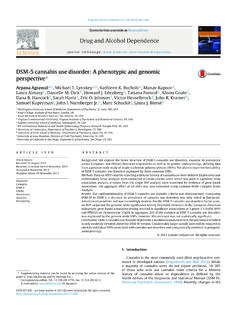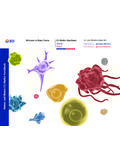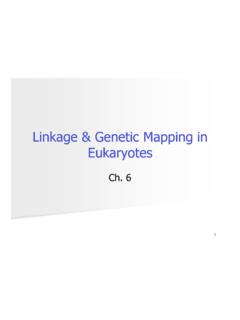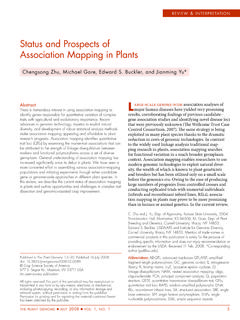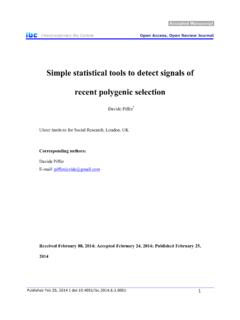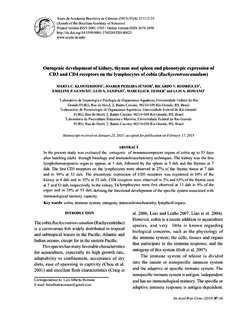Transcription of Antibodies in Scleroderma: Direct Pathogenicity and ...
1 Antibodies in scleroderma : Direct Pathogenicity and phenotypic AssociationsLorinda Chung, MD* and Paul J. Utz, MDAddress*Division of Immunology and Rheumatology, Department of Medicine, Stanford University School of Medicine, 1000 Welch Road, Suite 203, Stanford, CA 94305, : Rheumatology Reports 2004, 6:156 163 Current Science Inc. ISSN 1523 3774 Copyright 2004 by Current Science is a systemic connective tissue disease char-acterized by vascular damage and fibrosis involving theskin and other internal organs. Disease course, severity,and organ involvement are variable from patient topatient, and overlap syndromes with other autoimmuneconditions can occur [1]. The pathogenesis of this dis-ease is thought to involve three processes: 1) endothelialcell damage and intimal hyperplasia; 2) fibroblast activa-tion and overproduction of extracellular matrix compo-nents; and 3) stimulation of the immune response,leading to production of autoantibodies [2].
2 The vascularpathology manifests as Raynaud s phenomenon andischemic digital loss, while the excessive collagen deposi-tion results in skin thickening and fibrosis in variousorgans, such as the lungs, heart, kidneys, or gastrointesti-nal tract [3 ]. B cells from patients with sclerodermaoverexpress CD19, resulting in hyper-responsiveness andautoantibody formation [4]. Although the pathogenicrole of certain autoantibodies associated with sclero-derma can be explained on a molecular level, it is unclearwhether other autoantibodies are primary drivers ofpathology or represent a secondary response. A subset ofautoantibodies correlates with clinical expression of dis-ease and these may serve as prognostic clinical subtypes of scleroderma have beenidentified and are associated with distinct autoantibodypatterns. Diffuse scleroderma is clinically characterizedby skin thickening involving the face, neck, trunk, andproximal upper and lower extremities, as well as signifi-cant internal organ involvement, including the lungs,heart, gastrointestinal tract, and kidney.
3 Diffuse sclero-derma is classically associated with antitopoisomerase-Iantibodies (anti-topo-I or anti-Scl-70) and the absence ofanticentromere Antibodies (ACA) [5]. Limited sclero-derma involves skin thickening in the face, neck, and dis-tal extremities, with frequent development of isolatedpulmonary hypertension and ischemic digital loss. Aform of limited scleroderma with calcinosis, Raynaud sphenomenon, esophageal dysmotility, sclerodactyly, andtelangiectasias (CREST) is characterized by the presenceof ACA [5]. Overlap syndromes, such as mixed connec-tive tissue disease (MCTD), with features of systemiclupus erythematosus (SLE), polymyositis (PM), rheuma-toid arthritis (RA), and scleroderma are associated withanti-U1-small nuclear ribonucleoprotein particle (U1-snRNP) Antibodies [5]. This review summarizes the clas-sical and novel autoantibodies associated with sclero-derma, their putative pathogenic functions, and theircorrelation with disease Involved in Disease PathogenesisSeveral autoantibodies have been discovered in the seraof patients with scleroderma that may be directly patho- scleroderma is an autoimmune disease involving endothelial cell damage and fibroblast overproduction of extracellular matrix.
4 Several autoantibodies present in the sera of patients with scleroderma , including anti-endothelial cell, antifibroblast, anti matrix metalloproteinase, and antifibril-lin-1 Antibodies , may directly contribute to disease patho-genesis. scleroderma also is characterized by the presence of antinuclear and antinucleolar Antibodies , which correlate with particular phenotypes. These include antitopoiso-merase-I, anticentromere, antihistone, anti-polymyositis/ scleroderma , anti-Th/To, anti-U3-small nucleolar ribonucleoprotein particle, anti-U1-small nuclear ribonucle-oprotein particle, anti-RNA polymerase, and anti-B23 anti-bodies. Other Antibodies classically associated with other autoimmune diseases, such as antiphospholipid, antineutro-phil cytoplasmic, and antimitochondrial Antibodies , also have been described in patients with scleroderma . This review will summarize the various autoantibodies associ-ated with scleroderma , their putative pathogenic roles, and their phenotypic in scleroderma : Direct Pathogenicity and phenotypic Associations Chung and Utz157genic (Table 1).
5 These include anti-endothelial cell, anti-fibroblast, anti matrix metalloproteinase (MMP), andantifibrillin Antibodies . Currently, these autoantibodiesare not routinely analyzed in the clinical setting. Furtherstudies on large cohorts of scleroderma patients need tobe performed to define the sensitivity and specificity ofthese cell antibodiesAnti-endothelial cell Antibodies have been found in 28%to 71% of sera from patients with scleroderma [6] and areclinically associated with ischemic digital infarcts and pul-monary arterial hypertension [7]. These Antibodies mayhave a Direct pathogenic role by inciting vascular et al. [6] recently demonstrated that transfer of anti-endothelial cell antibody positive sera into normalchicken embryos induced endothelial cell apoptosis invivo. However, a sclerodermatous phenotype did notdevelop in these animals, implying that factors other thananti-endothelial cell Antibodies are required for diseaseexpression [6].
6 Antifibroblast antibodiesAutoantibodies directed against fibroblasts have beenrecently observed in 58% of sera from 69 patients with dif-fuse and limited scleroderma . These Antibodies werereported to induce fibroblast activation in vitro, resultingin increased expression of intercellular adhesion molecule-1 and production of the proinflammatory cytokine inter-leukin-6 [8]. Intercellular adhesion molecule-1 mediatesadhesion and transendothelial migration of mononuclearcells, leading to vascular damage and inflammation,whereas interleukin-6 release is associated with increasedextracellular matrix production [8].Anti matrix metalloproteinase antibodiesThe degradation of extracellular matrix is dependent on afamily of endopeptidases referred to as the MMP. MMP-1 isresponsible for initiating the breakdown of collagen typesI, II, and III, which are overexpressed in the skin of patientswith scleroderma [9].
7 Sato et al. [9] demonstratedincreased levels of anti-MMP-1 immunoglobulin (Ig) G insera from patients with scleroderma compared withhealthy control subjects and patients with other auto-immune diseases. The antibody titers correlated with thedegree of fibrosis in the involved tissues, with higher titersin patients with diffuse compared with limited disease,presumptively by inhibiting MMP-1 mediated collagenaseactivity [9].Antifibrillin-1 antibodiesElastic microfibrils of the extracellular matrix are partiallycomposed of a glycoprotein component called tight skin mouse represents a genetic model forhuman scleroderma . These mice have a mutation withinthe fibrillin-1 gene that is thought to be responsible forincreased collagen deposition and thickening of the tight skin mice also generate autoantibodies to fibril-lin-1, implicating this protein as a possible target in diseasepathogenesis [10].
8 Tan et al. [11] reported the presence ofantifibrillin Antibodies in approximately 80% of sera fromscleroderma patients of Choctaw American Indian and Jap-anese ethnic backgrounds; however, less than 50% of Cau-casian patients possessed Antibodies to fibrillin-1 et al. [12] showed that microfibrils from fibroblastsof patients with scleroderma are unstable, possibly becauseof Antibodies against fibrillin-1, with resultant dysregula-tion of extracellular matrix Associated with Clinical PhenotypesAntinuclear antibodiesAntinuclear Antibodies (ANA) are present in the sera ofmore than 95% of scleroderma patients, with certain clin-ical phenotypes associated with specific ANAs [13 ].Anti-topo-I and ACA are classically associated with sclero-derma, and respectively demonstrate nucleolar/homo-geneous and centromeric staining patterns on ANAscreening by immunofluorescence [14]. Antihistone anti-bodies (AHA), most commonly associated with drug-induced lupus, can occur in patients with scleroderma ,Table 1.
9 Autoantibodies with Direct Pathogenicity in sclerodermaAutoantibodyRole in pathogenesisClinical associationsStudyAnti-endothelial cellIncite vascular injury by inducing endothelial cell apoptosisIschemic digital infarcts; pulmonary arterial hypertensionWorda et al. [6] and Negi et al. [7]AntifibroblastInduce fibroblast production of ICAM-1 and IL-6, leading to vascular damage and ECM productionLimited sclerodermaChizzolini et al. [8]Anti matrix metalloproteinaseInhibit MMP-1 collagenase activityDiffuse sclerodermaSato et al. [9]Antifibrillin-1 Induce instability of microfibrils resulting in ECM accumulationChoctaw American Indian and Japanese ethnic backgroundsTan et al. [11] and Wallis et al. [12]ECM extracellular matrix; ICAM-1 intercellular adhesion molecule-1; IL-6 interleukin-6; MMP-1 matrix demonstrate a homogenous staining pattern onimmunofluorescence [14]. These three autoantibodiesare widely available in the clinical setting, whereas theless-common antinucleolar Antibodies have limited usein the routine clinical diagnosis of scleroderma [15 ].
10 Antitopoisomerase-I antibodiesAntitopoisomerase-I Antibodies are 100% specific for scle-roderma compared with normal control subjects, specific compared with patients with other connec-tive tissue diseases [15 ]. The sensitivity of various assaysfor anti-topo-I Antibodies , including immunodiffusion,immunoblotting, and enzyme-linked immunosorbentassay, varies from 20% to 43% [15 ]. Patients with anti-topo-I Antibodies usually have diffuse cutaneous involve-ment, and frequently develop peripheral vascular disease,pulmonary fibrosis, cardiac involvement, and coexistingmalignancies [13 ]. Although no definitive role in patho-genesis has been determined for anti-topo-I Antibodies , Huet al. [13 ] recently demonstrated that anti-topo I IgG titersfluctuate with disease activity and total skin score. Theseantibodies may provide prognostic information and serveas markers of disease antibodiesAnticentromere Antibodies also are highly specific forscleroderma, though patients with primary Raynaud sphenomenon alone or with other connective tissue dis-eases can develop ACA [15 ].
